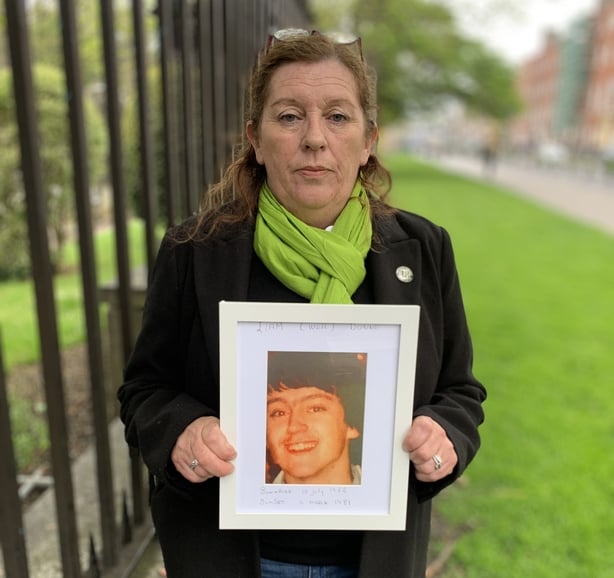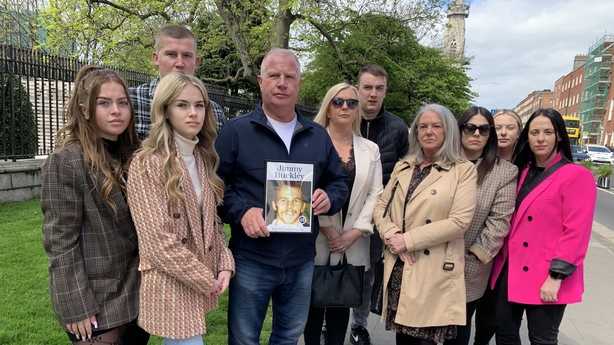Michael Barrett, Richard Bennett, Carol Bissett, James Buckley, Paula Byrne, Caroline Carey, John Colgan, Jacqueline Croker, Liam Dunne, Michael Farrell, David Flood, Thelma Frazer, Michael Ffrench, Josephine Glenn, Michael Griffiths, Robert Hillock, Brian Hobbs, Eugene Hogan, Murtagh Kavanagh, Martina Keegan, Mary Keegan, Robert Kelly, Mary Kennedy, Mary Kenny, Margaret Kiernan, Sandra Lawless, Francis Lawlor, Maureen Lawlor, Paula Lewis, Eamon Loughman, George McDermott, Marcella McDermott, William McDermott, Julie McDonnell, Teresa McDonnell, Gerard McGrath, Caroline McHugh, Donna Mahon, Helena Mangan, James Millar, Susan Morgan, David Morton, Kathleen Muldoon, George O'Connor, Brendan O'Meara, John Stout, Margaret Thornton and Paul Wade.
These are the names of 48 young people who lost their lives in the February 1981 fire at the Stardust nightclub in Dublin.
Young people who as Monica D'Arcy, niece of one victim Michael Farrell explained, are "still suspended in time and waiting for accountability".
Young people who as Caroline Tiernan, a sister of another victim Michael Ffrench said, have "left a void that can never be filled".
Four decades ago, the 48 people named above got ready for a night out at the Stardust in Artane just like countless people do around St Valentine's Day each year.
They picked out their outfits, looked forward to an enjoyable night of music and fun, and left their houses with a smile on their face.
They never came home.

Within hours, these young people were faced with an inferno that took their lives and injured 215 others - an incident which despite 42 years of tireless campaigning by their loved ones is still peppered with unanswered questions which continue to haunt those involved.
This, in its most raw, basic terms, is the reason why the Stardust disaster is now back in a spotlight many feel should never have left it.
Last year, the High Court ruled a new inquest into what happened should be opened and, crucially, that it should allow the hearing to come to a conclusion of 'unlawful killing' if it chooses to reach this verdict.
The decision follows initial inquests into the disaster which controversially focused only on medical causes of the deaths and not the context for how they occurred, a situation which has meant no criminal prosecutions have been brought.
It also follows a number of independent investigations, which far from bringing clarity to the story have caused more confusion, with the 1981 Keane Tribunal concluding the blaze had probably been caused by arson while the 2008 Coffey Inquiry argued this was not "justifiable on the evidence".
For the families and loved ones left to live with the consequences of what happened, these contradictions and half-answered questions are why the new inquest taking place is so important.
Since the final week of April, for four days a week the Pillar Room in the Rotunda Hospital has been home to the Dublin District Coroner's Court's attempts to get to the bottom of what happened at the Stardust.
The inquest is expected to be the most extensive held in this jurisdiction and is likely to last up to six months, with planned evidence from at least 350 witnesses and affected parties.

The first of these groups are the families and loved ones of the 48 people who died, who - in a first for the legal system in Ireland - have been allowed to read "pen portraits" of those who died into the records.
Similar portraits, which amount to an oral history of the real people behind the names, have been used in legal cases by those affected by the Hillsborough football disaster in the UK and the Ballymurphy massacre in Northern Ireland, but have never before been used in this way in the Republic of Ireland.
It will then examine still unanswered questions about what happened - including where and how the fire started; how it progressed; and the circumstances and contributory factors that may have helped cause or exacerbated the blaze.
This is likely to include a focus on design of the Stardust ballroom building itself; whether there were any prior inspections; the management of the nightclub; and the nature and extent of staff training and fire prevention planning.
It will also involve an examination of the response within the Stardust when the fire broke out; the role of emergency services; and, ultimately, the haunting question of whether the deaths of some or all of the 48 victims could have been prevented.
Once the pen portraits have been read into the record, these questions will be broken down into three sections of the inquest:
The first section will be eyewitness testimony that will include the views of the nightclub's staff and management.
The second will focus on Dublin Fire Brigade's response and the garda investigation.
The third module will zone in on expert evidence.
Justice is not just a word, it's a commitment to the innocent souls lost in the Stardust fire, and to the 48 lives that were cut short. Let their tragedy be a reminder that we must never tire in our pursuit for justice. pic.twitter.com/ArJfOm4CcU
— Justice for Stardust 48 (@48NeverCameHome) April 9, 2023
All of the evidence will be heard at the Pillar Room in the Rotunda Hospital complex in Dublin, and under the gaze of 48 faces of photos of those who died, framed in a large gallery image taking up a large section of an internal wall just metres from where witnesses will speak and under the equally piercing watch of the surviving loved ones of those who died, many of whom are attending.
They include Ciaran David Flood, who said his young uncle David - an 18-year-old with a love of music and a "[Mick] Jagger swagger" - had his future robbed from him, leaving his relatives to go to his graveside every St Valentine's Day to tell stories of the young man they knew.
And Stardust survivor Antoinette Keegan, whose sisters Mary and Martina died in the fire and who says what happened is "a living nightmare" that never leaves her mind as "I consume it morning, noon and night".
So too Betty Bissett, whose daughter Carol died in hospital three days after the fire - a heartbroken Betty told the inquest: "I wasn't there to hold her hand or tell her I love her."
And Carol's sister Liz, who was seven years old when the tragedy happened, and wrote a poem which she read on the opening day of the inquest which included the lines:
"My grief with memories, I bury deep. They only surface when I sleep."
The coming months of the new Stardust inquest will inevitably force that grief back to the surface in the search for answers. Those involved hope it will not be in vain.







